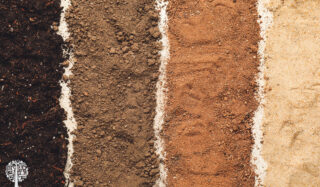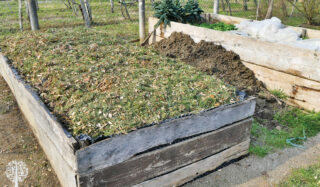We celebrate National Gardening Day (April 14th) to encourage people everywhere to start a garden, regardless of size or whether they want to grow veggies, flowers, or both! It’s important to stress that gardening doesn’t have to be a ton of work. Regenerative gardening is about working with nature to grow plants that feed your family or beautify your home. Lasagna gardens are a big part of the regenerative way and are easy to build, so why not add this idea to your vision board for the growing season ahead?
What’s a Lasagna Garden?
A lasagna garden is the idea of composting in place and growing plants simultaneously. Like making a lasagna, you create a garden bed by layering organic materials to build soil.


To make a lasagna garden bed, you’ll need a nitrogen source like grass, garden clippings, or kitchen scraps. Nitrogen makes up one-third of the bed. For the other two-thirds, you’ll need carbon sources like cardboard, newspaper, fallen leaves, or woody material. With some air and water, you’ll be on your way to building soil full of organic matter, nutrients, and microorganisms that feed plants.
I recently had the opportunity to chat with Stephanie Rose, author of two of my favorite books, Garden Alchemy and The Regenerative Garden. Rose says lasagna gardening, also known as sheet mulching, is a great way to build a bed quickly. Just pick a spot on the lawn and get layering!
“If you’re not going to make it very deep, you can turn all of the turf upside down to prevent some of the grass from coming through,” she says. “Or, you can leave it as is and put a thicker layer of paper or cardboard over top of the space that you’re going to [turn into] a garden. And then, layer carbon and green materials, put compost on top of that, and plant right into it.”
Rose says the top layer of compost must be aged or finished for planting directly into the bed. As the material underneath decomposes, the plants take up nutrients through their roots, eliminating the need for supplemental fertilizers and turning the soil.
“Who hasn’t grown some vegetable in the compost pile and then went and told everybody and their dog how they had the most delicious tomatoes?,” she asks. “They had hundreds of tomatoes; they had so many squash; they had so many zucchini because it was growing out of a compost pile!”


A lot like Hugelkultur
Lasagna gardens are the same idea as hugelkultur, where you build a mound with organic materials and plant right into it.
In a hugelkultur bed, you layer woody materials that are slow to decompose, such as logs, sticks, fruit pits, nut and egg shells, on the bottom of the bed. Then, you begin sheet mulching.
“The one thing about a hugelkultur that I love is that you can build this in your plant pots, too. Put big pieces of rotting wood in there,” Rose says. “If you’ve ever been into the forest and seen those big pieces of rotting wood, they’re like sponges. They just hold on to the water, so it reduces the supplemental water that you need.”
Creating a hugelkultur container garden is like building a mini eco-system and means filling the pot with less soil. Rose suggests finding a rotting piece of untreated hardwood and spot composting. You can make a worm tower by inserting a small tube into the soil and feeding worms with kitchen scraps and leaves. Or, you can dig a hole, hide some kitchen waste, and cover it with leaves and shredded paper. Creating organic matter in a container garden that doesn’t need much water has never been so easy!
“I see people do these things like putting diapers into their hanging baskets because it holds onto water or sponges into hanging baskets,” laughs Rose. “It just takes some big chunks of wood to do the same thing, and it has all this beneficial fungal matter. It’s got that lovely bacteria in it, but it also holds onto water like a sponge so that plants can access it in times of drought as it decomposes and builds the soil.”
Lasagna and hugelkultur gardens are easier than the alternative! Who needs to order truckloads of garden soil and dig for hours when they can sheet mulch with a few easy-to-find organic materials?
For more garden advice, check out our other blogs and Rose’s incredible books, Garden Alchemy and The Regenerative Garden.
![]()
